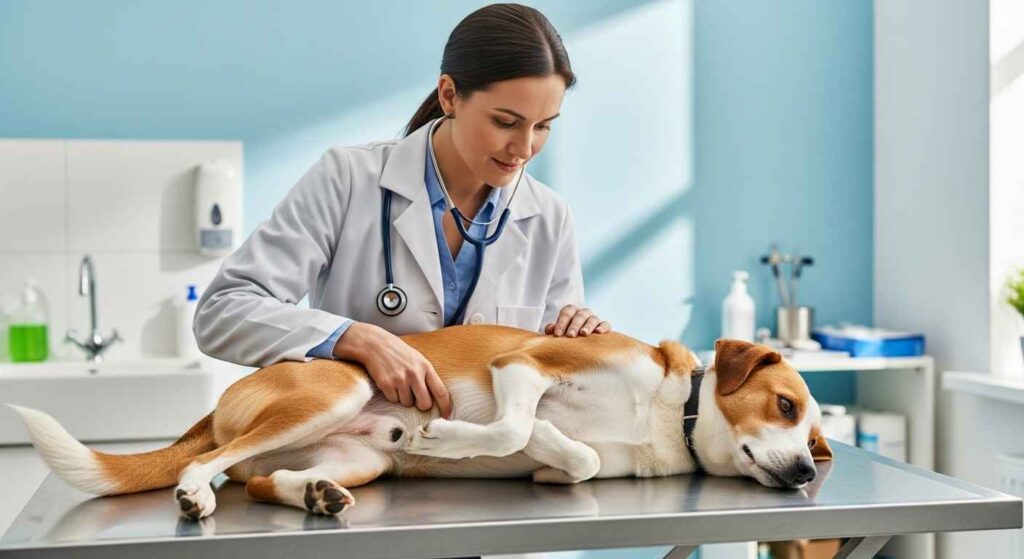Dogs shake for many reasons. Some are harmless, like excitement or cold. Others, like pain or illness, need attention. This guide explains why dogs shake, how to spot serious issues, and what to do. We’ll keep it clear and simple, so you know when to act.
Normal Reasons Dogs Shake
Some shakes are no big deal. They stop on their own. Here are the common ones.
Cold Weather
Dogs shiver to warm up. Small breeds, like Chihuahuas, feel cold more because they have less body fat. Shivering moves muscles to create heat.
If your dog shakes outside, bring them indoors. Use a blanket or a dog coat for walks. Check paws for ice buildup.

Excitement
Dogs tremble when happy. This happens during play, greetings, or when they see a treat. It’s their body reacting to joy.
Look for a wagging tail or perky ears. The shaking stops when they calm down. No need to worry.
Check our pet compatibility checker to see if your dog plays well with others.
Fear or Stress
Loud noises, like thunder or fireworks, scare dogs. New places or people can stress them too. This leads to shaking.
Other signs include panting, hiding, or flattened ears. Remove the trigger if possible. Stay calm to help your dog relax.
Use our pet symptom checker to track stress behaviors and share with your vet.
Wet Fur
Dogs shake to dry off after baths, rain, or swimming. This is normal and helps them avoid getting too cold.
Towel-dry them to reduce mess. It’s quick and effective.
Serious Reasons Dogs Shake
Some shakes signal health problems. These need a vet’s attention. Watch for other symptoms, like vomiting or lethargy.
Pain
Dogs often hide pain, but shaking can be a clue. Arthritis, injuries, or stomach issues may cause it. Older dogs are more likely to shake from joint pain.
Look for limping, whining, or less activity. Contact a vet for pain relief options, like rest or medication.
Read our guide on what can I give my dog for pain for safe ideas.

Toxin Ingestion
Eating toxic things, like chocolate, xylitol, or plants, can cause shaking. Other signs include vomiting, diarrhea, or seizures.
Act fast. Call your vet or a pet poison hotline right away. Don’t wait for symptoms to worsen.
Use our pet food safety checker to avoid harmful foods. Learn more in our posts on can dogs eat mushrooms or can dogs eat bacon.
Infections or Diseases
Viruses like distemper cause shaking, especially in unvaccinated puppies. Symptoms include fever, coughing, or eye discharge. Low blood sugar (hypoglycemia) in small dogs can also trigger shakes.
Keep vaccines up to date to prevent distemper. Feed small dogs frequent meals to stabilize blood sugar. A vet can run tests to confirm.
See our post on can dogs get flu for more on dog illnesses.
Seizures
Seizures cause intense shaking. Dogs may fall, paddle their legs, or lose awareness. This is different from normal shaking, which doesn’t affect mobility.
Keep your dog safe during a seizure. Time it and note details. Call a vet afterward for tests or medication.
Ear Problems
Frequent head shaking often means ear issues. Infections or allergies cause itching and pain. Look for redness or a bad smell.
Clean ears gently with vet-approved solutions. A vet can prescribe medication.
Check our post on can dogs get lice for other skin-related issues.
Old Age
Senior dogs shake due to weak muscles or arthritis. Their joints may ache, especially in cold weather.
Provide soft bedding and warm spaces. Regular vet visits help manage age-related issues.
Use our pet age calculator to understand your dog’s life stage.
When to See a Vet
Most shakes are harmless, but some need urgent care. Contact a vet if:
- Shaking lasts more than an hour.
- Your dog vomits, has diarrhea, or acts lethargic.
- Shaking starts suddenly with no clear cause.
- Your dog seems disoriented or loses mobility (possible seizure).
- Puppies or senior dogs shake frequently.
For shaking while sleeping, it might be dreaming, but check for fever. Shaking with panting could mean heatstroke or pain. Shaking with vomiting is an emergency.
How to Help Your Dog at Home
You can ease some shaking at home. Try these steps:
- Warm them up: Move a cold dog to a warm spot. Add blankets or a sweater.
- Calm stress: Create a quiet space during loud events. Stay relaxed to reassure them.
- Prevent toxins: Keep harmful foods and plants out of reach. Check our pet food safety checker.
- Feed regularly: Small meals prevent low blood sugar in small breeds.
- Exercise daily: Walks reduce stress and excess energy.
Explore our pet breed finder quiz to find breeds less prone to shaking.

Prevention Tips
Prevent shaking with these habits:
- Vaccinate: Keep shots current to avoid diseases like distemper.
- Safe diet: Feed only dog-safe foods. See our guides on what fruits can dogs eat or is watermelon good for dogs.
- Train for calm: Teach your dog to stay relaxed in new settings.
- Regular checkups: Vets catch problems early.
For heart-related concerns, read our guide on DCM in dogs.
Have fun naming your pup with our pet name generator.
People Also Ask: Quick Answers
- Why is my dog shaking and panting? Could be stress, pain, or heatstroke. Check for other symptoms and call a vet if it persists.
- Is shaking normal for small dogs? Yes, small breeds like Chihuahuas shake more due to cold or excitement, but watch for unusual patterns.
- Can shaking mean my dog is sick? Yes, it can signal illness like distemper or low blood sugar. A vet can diagnose.
- What if my dog shakes while sleeping? Likely dreaming, but fever or seizures are possible. Monitor and consult a vet if frequent.
Dog shaking can be normal or serious. Watch your pet closely. Use our tools to stay informed. When in doubt, call your vet. Your dog’s health comes first.
